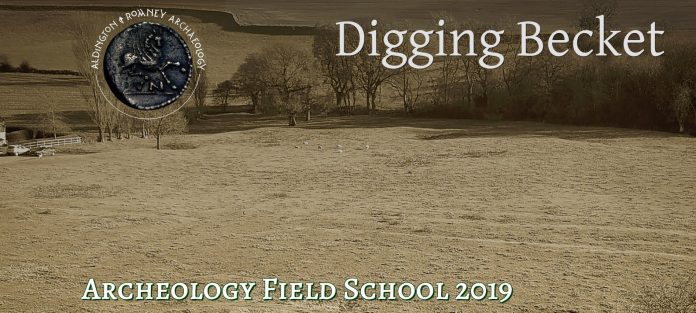Since 2016 Aldington & Romney Archaeology have been engaging in excavations to uncover the story behind Thomas Becket’s palace at Aldington. The earliest written sources tell us that a church was originally constructed adjacent to the site of the Archbishop’s estate around 600 CE, most likely a small timber framed structure of which nothing has survived and you can get involved this summer.
Around 800 CE the records at Canterbury state that the original church has been replaced by the first stone church dedicated to St. Martin. By 1086, the Domesday Book tells us that the church has been amalgamated into a large archiepiscopal estate that includes a large stone construction that most likely would become the Archbishop’s lodge.
The church held several lands around Aldington and Romney Marsh since shortly after the arrival of St. Augustine in the area in 597 CE. However, the topography of the area was vastly different to the landscape that can be seen today. That is in no small part down to the efforts of Thomas Becket.
Becket was appointed Chancellor by King Henry II in 1155 and was given large amounts of land on what was to become Romney Marsh. These lands were mostly intertidal and effectively swampy, marshy and boggy. This made the land initially uninhabitable and rife with malaria. Work began to reclaim areas of the Marsh in 1160, this allowed the land to be worked and eventually inhabited in certain areas (fig 1).
When Becket was appointed Archbishop in 1162, all the lands in and around Romney Marsh, including Aldington, became the property of the church. Thomas established his palace at Aldington in order to facilitate the collection of revenue from the income generated around the area.
By the time of Becket’s murder in Canterbury in 1170, the palace had grown in size and prominence, most likely to facilitate visiting Barons and other dignitaries. There is no evidence to suggest Henry II ever visited the estate but given the size of the estate and its facilities, it is more than possible.
An inventory of the estate, listed possibly shortly after Thomas’ murder, mentions that the estate includes a stone lodge (palace), a kiln, blacksmiths, lodgings for around three hundred servants, three stables, six kitchens, all enclosed within a perimeter wall and included a gatehouse. The lands under the control of the Archbishop adjacent to the palace boundary included three fish ponds and a chase.
After the death of Becket, the property came into royal ownership and was extended even further. The chase became a deer park and further stabling was added and a number of dovecotes and other farm buildings were constructed. The archaeological area covers just over two acres of land (fig 2).
In 2016 and 2017 Aldington and Romney Archaeology carried out a resistivity survey of part of the site to establish how much of the archaeology remained in situ (fig 3). The completion of the survey is due to be carried out during the summer of 2019 (the large black areas of the image show the remainder of the site still to be surveyed).
The areas targeted in the two trenches was the suspected area of the gatehouse. It was our intention to determine the location of the main entrance to the palace perimeter. We believe that is what is shown in fig 5. We have two areas of building debris at the north and south ends of the trenches and a compacted area between. This area will be re-visited and the excavation area enlarged this season.
The site has yielded many artefacts, enabling us to date certain areas of the excavation, including 10th, 11th and 12th century pottery. We also have a large amount of building material, including roof and decorated floor tiles. Perhaps one of the most intriguing finds to date is that of a mediaeval arrowhead (fig 4). The arrowhead has been dated to the fifteenth century, so a bit late for Becket to have handled it but certainly lends itself to the idea of hunting in the area and possibly related to the deer park.
Get involved
If you are interested in taking part in the field school, details can be found at www.digbecket.co.uk or email chris@digbecket.co.uk.
Aldington and Romney Archaeology also support the BAJR Skills Passport scheme.
Skills taught:
Surveying
Students can partake in field walking, geophysics such as resistivity.
Excavation
Excavation will be an integral part of the investigation of the site. The school will teach theory and methodology behind archaeological excavation as well as practical training.
Recording
Archaeological recording is integral to excavation. Students can learn how to record the archaeological environment, interpret features and develop drawing and photographic techniques essential to any archaeological investigation.
Finds processing
Any finds recovered during excavation will be recorded and then processed. This will include cleaning and marking pottery, sorting finds by their type and photography.





